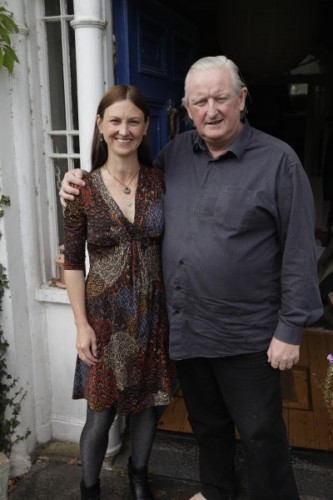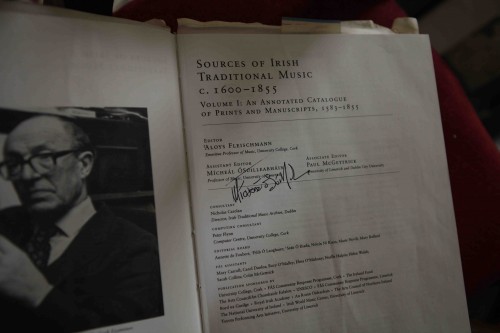On the 11th day of our tour we visited the renowned composer and pianist Mícheál Ó Súilleabháin at his home in Tipperary. Éamonn a’ Chnuíc (1670 – 1724), or Ned of the Hill, was from this area. Mícheál is a font of knowledge about traditional Irish music.

He took us on a journey of discovery of the evolution of this air using the book “Sources of Irish Traditional Music, c.1600 – 1855” edited over a period of several decades by his former teacher, Aloys Fleischmann. Mícheál himself also participated in the editing of this work. The book contains about 7000 transcriptions of traditional tunes and their references.

For Éamonn a’ Chnuíc he identified four versions of the tune dating from 1745, 1789, 1849 and from the 1920s. Mícheál played them on the piano and it was fascinating to hear how the tune has evolved over time.
He elaborated on the history behind the words of the air:
“Éamonn a’ Chnuíc was a Robin Hood kind of a figure, a folk hero. He was involved in the war over the kingship of England between the Dutch Stadtholder William III of Orange-Nassau, who was a Protestant, and James II of England (and Ireland), who was bringing Catholicism to England, Scotland and Ireland. Éamonn a’ Chnuíc would have fought for James’ side.
The Irish text of the air starts off with a question: “Who is that outside, with the edge in his voice, who is banging on my closed door?” And then the answer comes from in a way beyond the door: “I am Éammon of the Hill. I am drowned, cold and wet from continually walking the mountains and the glens”.
So the text is set up as a kind of dramatic scene, a rapparee or bandit who is wandering the hills of Tipperary, the Glens of Aherlow, the Glen of Aherlow, the area here, north and mid Tipperary Upper Church, which is quite near from here which is where he was born.
The text goes on and presumably a she from inside replies: “My dear, dear love, what will I do for you?”
There is a numinous reference, that gunpowder will blow us up, unless we can be protected.
So the song does not come across as being written by Éamonn himself. We know the tune appeared first in 1745, and it’s called Eamonn a’ Chnuic, and therefore the text must have been there by then. And 1745 is approximately twenty years after Éamonn a’ Chnuíc dies.”
After talking to Mícheál, we filmed Ilse playing the air in the garden of his house.




